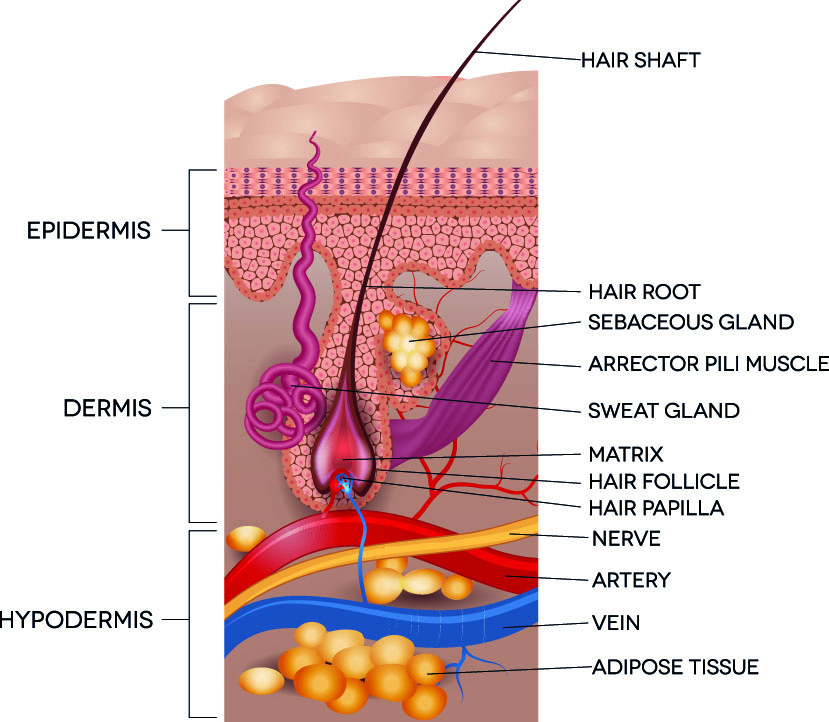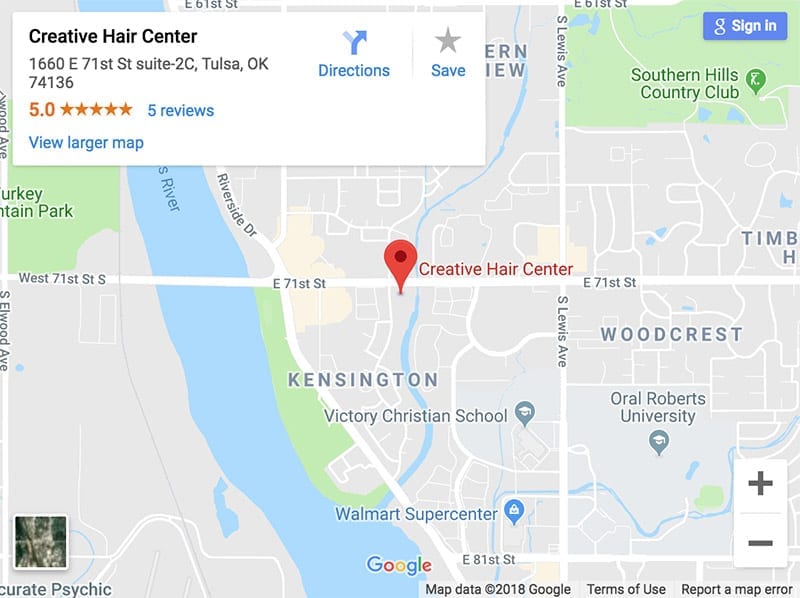Hair Growth Facts
Histology
This isn’t biology class – but we do use real science.
We use this knowledge to help you know exactly how healthy your hair and scalp are.
What is Hair Made Up Of?
Like skin, hair is a stratified squamous keratinized epithelium (Say that ten times fast) which is made up of multi-layered flat cells with a coating of keratin.
Keratin’s rope-like filaments provide structure and strength to the hair shaft.
The Hair Growth Cycle
(No. These are not names of planets from Star Trek)
All three of these phases occur simultaneously.
You may have one strand of hair in the anagen phase while another is in the telogen phase.
Once the cycle is complete, it starts over, creating a new strand of hair.
Did you know? On average, hair grows at a rate of 1.25 cenitmeters or .5 inches per month
Anagen
The Anagen phase is commonly referred to as the “Growth phase”.
It beings in the dermal papillae (the base of the hair folicle).
The amount of time that the hair remains in this stage is primarily determined by genetics.
The longer a hair stays in the Anagen phase, the faster and longer it will grow.
When one of your hairs is in the Anagen phase, the cells are actually dividing to produce new hair fibers and the hair follicle is burying itself into the dermal layer of your skin to keep the strand of hair healthy.
About 85% of the hairs on your head are in the Anagen phase at any given time.
Catagen
Signals sent from your body will control when the Anagen phase ends and the Catagen phase begins.
The Catagen phase is typically referred to as the transitional phase.
During this phase of hair growth, the follicle renews itself. How does it do this?
The follicle shrinks due to disintegration and the papilla detaches and “Rests”, cutting off the hair strand from its nourishing blood supply.
The hair follicle is at that point 1/6th the size of its original length, causing the hair shaft to be pushed upwards.
This upwards push increases the length of the terminal fibers.
Telogen
The Telogen phase is also called “The Resting Phase”.
During this time, the hair strand and follicle both remain dormant for anywhere from one to four months.
At any given time, 10%- 15% of the hairs on your head are in this phase of the hair growth cycle. The Anagen phase can not begin again until the Telogen phase is finished.
When the cycle does start over with the Anagen phase, the old hair strand is then pushed up and out by the new growing strand.
Some people call this hair loss or shedding.
Hair Growth Inhibitors
Chemotherapy
Most chemotherapy drugs work by attacking fast replicating cells, which is a hallmark of cancers.
It also happens to be a hallmark of hair follicle cells.
This is why chemotherapy disrupts the hair growth cycle, inhibiting hair growth during chemo treatment.
Your doctor should be able to tell you how your specific dosage will affect hair loss.
The good news: Once chemotherapy has ended, you can experience hair growth again.
The typical time frame to see hair growth after chemo has ended is three to ten months.
Alopecia
Alopecia is a hair loss disease that affects people at any stage of life.
Most common, when Alopecia is mentioned, you’ll hear about Alopeica Areata.
Alopeica Areata has been classified as an autoimmune disease that causes spontaneous hair loss.
This is often seen as bald patches on the scalp or other parts of the body, and can lead to baldness on one’s entire body.
Why Does This Cause Hair Loss?
Alopecia interferes and disrupts the hair growth cycle by causing the hair follicle to leave the Anagen phase too early.
The hair follicle enters the Telogen phase too early before it’s had time to grow properly, and the growth is stopped prematurely.
Traction Alopecia
Traction Alopecia occurs when there is too much strain on your hair.
We see it a lot with tight pony tails or other hair styles that require a high level of tension on the hair strands.
Our Approach For Hair Growth
Keep It Simple
There are a lot of products out there with a lot of claims.
The truth is, the only thing that is going to work is products that nourish the follicle and help provide or increase blood flow.
It’s easy to get lost in the complexity of what different products and treatments try to address.
We know it is a disruption of “the hair growth cycle”, but there are so many variables causing this problem that it is impossible to cure hair loss until we can control or alter the genetic makeup of our bodies.
Once and if this occurs we will have cured almost all know genetic diseases as well. As far as growing hair back in the pretense of a full head of hair growing on a bald head that is the original type, color, texture as you once originally had, well we are many, many years from this.
The follicle is a an organ just as any other living organ of the body. If the organ is dead then it is dead.
To bring life back to an organ in this day and age, with the knowledge and experience we have, is just impossible. Yes, we are having some luck growing hair in a Petri dish or cloning hair, but as with any organ and the transplant of an organ, there are many complications and much expense.
As we develop in this science, it makes perfect logic and sense that we will learn how to keep the organs that go bad in our bodies including the hair follicle, from being attacked by various bad proteins in the first place.
By possibly coming up with a protective protein encapsulation process and preventing the disease, it makes more sense and will eventually be much more of an economical process.
Alopecia interferes and disrupts the hair growth cycle by causing the hair follicle to leave the Anagen phase too early.
The hair follicle enters the Telogen phase too early before it’s had time to grow properly, and the growth is stopped prematurely.
Help Is Here
How can we help you?
Creative Hair Center is located in the Shops at Bridgepoint, near the corner of 71st Street and S. Trenton Ave in Tulsa. If you are heading towards riverside on 71st Street, our offices are on your left.
Hours of Operation:
Tuesday - Friday: 9am to 5pm
Saturdays: 9am to 3pm
Need help finding us?
Business Hours:
| Monday | Closed |
| Tuesday | 9:00am - 5:00pm |
| Wednesday | 9:00am - 5:00pm |
| Thursday | 9:00am - 5:00pm |
| Friday | 9:00am - 5:00pm |
| Saturday | 9:00am - 3:00pm |
| Sunday | Closed |






